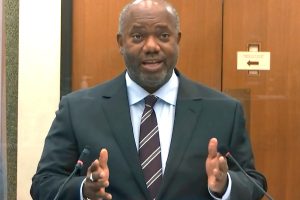Chauvin trial validates cameras in the courts

America’s application of jurisprudence – our court and trial system – was arguably on trial this month for all the world to see from the Hennepin County Courthouse in America’s heartland.
Former police officer Derek Chauvin’s televised murder trial pulled back the curtain for anyone to watch our justice system at work during one of the most tumultuous times in America in decades. Riots, racial disharmony and policing practices percolated throughout a year-long pandemic and divisive presidential election. Pent-up political and social turbulence culminated in downtown Minneapolis for the criminal trial following the death last May of George Floyd, a 46-year-old Black man in police custody.
All eyes on the trial
All eyes were on the court during jury selection, opening arguments, testimony from 45 witnesses (some off camera) and closing arguments. For nearly 10 hours over two days, the jury of Chauvin’s peers deliberated the three charges against him. Video livestreams and televised broadcasts helped satisfy the court of public opinion that the court proceedings unfolding before their eyes were fair and balanced. The public watched as the 12-member jury confirmed one-by-one its unanimous guilty verdict on all three counts for the murder of George Floyd. Then, they watched as Judge Peter Cahill thanked the jury for their “heavy-duty jury service” and saw the convicted defendant remanded into custody until sentencing.
During the trial, the jury watched video footage and heard witness testimony of George Floyd telling the defendant, “I can’t breathe.” The televised proceedings allowed the public to watch the wheels of justice turn. In doing so, the nation was able to see the verdict rendered with full transparency thanks to cameras in the court.
Prosecutor Jerry Blackwell in court on April 15, 2021, in Minneapolis. (Photo: AP)
I applaud Judge Cahill for making the decision to allow cameras in his courtroom. Transparency brings accountability. Considering the overheated rhetoric and injudicious comments from elected officials before the verdict was handed down, cameras in this courtroom allowed the American people to watch every moment and dissect every syllable of testimony with their own eyes and ears.
The Supreme Court has upheld constitutional guarantees for the accused to a fair trial by an impartial jury and for the public to have reasonable access to criminal trial proceedings in the First and Sixth Amendments. Judge Cahill took into consideration the extraordinary interest in the Chauvin trial and consented for it to be “recorded, broadcast and livestreamed in audio and video.”
Racism and justice: On racial and criminal justice, Biden has shown some promise, but little progress
Cameras in the Hennepin County courtroom didn’t tilt the scales of justice, disrupt court proceedings or infringe on due process of the accused. If anything, the live feed delivered unfiltered assurance to the American people. It showed our system of justice at work and affirmed the independence of the judiciary as an impartial arbiter of the rule of law.
Boosting public trust
As the Republican leader of the Senate Judiciary Committee, I’ve long championed sunshine laws to boost public trust in government. That includes leading a years-long bipartisan crusade to allow cameras in the courts, including the highest court in the land. The Supreme Court limits access to court proceedings, with often only a few unreserved seats available to the general public, and prohibits televised or video livestreaming. It’s an antiquated practice that I’m working to change. That’s why I ask Supreme Court nominees for their views on the matter during their confirmation hearings. In the 21st century, it’s unreasonable for the Supreme Court to delay and deny cameras in the court. To be sure, the Chauvin trial arguably rendered another verdict by validating the merits of my sunshine in the courts bill. The public benefit tips the scale of justice to allow cameras in the court.
Don’t forget a majority of state courts allow cameras with discretion by judges to limit or prohibit coverage of trial proceedings. What’s more, non-invasive technologies dismiss the argument it would be disruptive to court proceedings. Finally, the public’s appetite to digest live proceedings of the Supreme Court is growing. Millions tuned in to hear its proceedings when the pandemic forced the high court to hear cases remotely and livestreamed audio began.
Joe Biden’s economy 100 days in: An inflationary disaster? Or a policy for the people?
Cameras in our courts fortify the public trust in our nation’s administration of justice. In these times of racial, political and social divide, that’s a priceless public good that can help rebuild faith in one another and our civic institutions.
Chuck Grassley, a Republican, is the senior senator from Iowa and Ranking Member of the Senate Judiciary Committee.
You can read diverse opinions from our Board of Contributors and other writers on the Opinion front page, on Twitter @usatodayopinion and in our daily Opinion newsletter. To respond to a column, submit a comment to [email protected].
Source: Read Full Article

